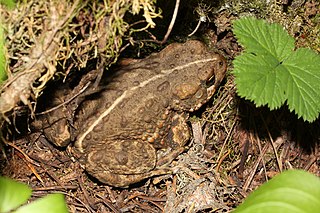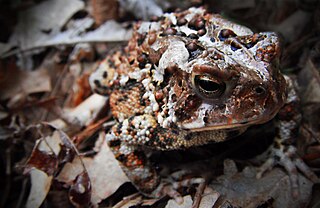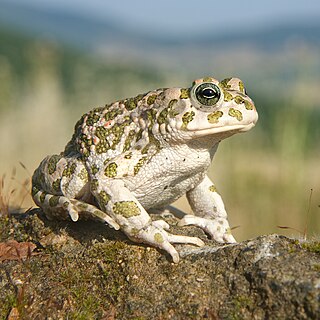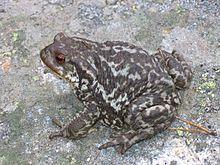
The cane toad, also known as the giant neotropical toad or marine toad, is a large, terrestrial true toad native to South and mainland Central America, but which has been introduced to various islands throughout Oceania and the Caribbean, as well as Northern Australia. It is a member of the genus Rhinella, which includes many true toad species found throughout Central and South America, but it was formerly assigned to the genus Bufo.

The common toad, European toad, or in Anglophone parts of Europe, simply the toad, is a frog found throughout most of Europe, in the western part of North Asia, and in a small portion of Northwest Africa. It is one of a group of closely related animals that are descended from a common ancestral line of toads and which form a species complex. The toad is an inconspicuous animal as it usually lies hidden during the day. It becomes active at dusk and spends the night hunting for the invertebrates on which it feeds. It moves with a slow, ungainly walk or short jumps, and has greyish-brown skin covered with wart-like lumps.

The Colorado River toad, also known as the Sonoran Desert toad, is a toad species found in northwestern Mexico and the southwestern United States. It is well known for its ability to exude toxins from glands within its skin that have psychoactive properties.

The American toad is a common species of toad found throughout Canada and the eastern United States. It is divided into three subspecies: the eastern American toad, the dwarf American toad and the rare Hudson Bay toad. Recent taxonomic treatments place this species in the genus Anaxyrus instead of Bufo.

The western toad is a large toad species, between 5.6 and 13 cm long, native to western North America. A. boreas is frequently encountered during the wet season on roads, or near water at other times. It can jump a considerable distance for a toad. Breeding occurs between March and July in mountainous areas, and as early as January in lower-elevation regions. The female lays up to 17,000 eggs stuck together in strings that adhere to vegetation and other objects along water edges.

The Wyoming toad, also known commonly as Baxter's toad, is a species of toad in the family Bufonidae. The Wyoming toad is an extremely rare amphibian that exists only in captivity and within Mortenson Lake National Wildlife Refuge in Wyoming in the United States. The Wyoming toad was listed as an endangered species in 1984, and listed as extinct in the wild since 1991. As with black-footed ferrets at the Tom Thorne and Beth Williams Wildlife Research Center at Sybille in Wheatland, Wyoming, the effort to save the Wyoming toad has been a cooperative effort among state and federal agencies and private landowners. The Wyoming toad was common from the 1950s through the early 1970s, but its distribution was limited to the Laramie Basin in Albany County. The population crashed around 1975 and was extremely low by 1980. The Wyoming toad was federally listed as endangered in January 1984. To prevent extinction, a captive-breeding program began in 1989 at the Thorne Williams Unit that produced enough offspring in its first few years to supply seven zoos, and in 1998 the Saratoga National Fish Hatchery received captive-breeding stock. Nearly 46,000 offspring were produced at the Thorne Williams Unit from 1995 until 2006, when the remaining captive stock was moved to the Red Buttes Environmental Biology Laboratory south of Laramie, and then released back into the wild. Before the sharp declines occurred, this toad had been originally classified as Bufo hemiophrys baxteri, a subspecies of the Canadian toad, by Kenneth Raymond Porter in 1968.

The southern toad is a true toad native to the southeastern United States, from eastern Louisiana and southeastern Virginia south to Florida. It often lives in areas with sandy soils. It is nocturnal and spends the day in a burrow. Its coloring is usually brown but can be red, gray, or black. It is approximately 8 cm (3 inches) long.
Sclerophrys taiensis is a species of toad in the family Bufonidae. It is known from the Taï National Park in southwestern Ivory Coast and from the Gola Forest in southeastern Sierra Leone; it is likely that its range extends into the adjacent Liberia. Common name Tai toad has been proposed for it.

Fowler's toad is a species of toad in the family Bufonidae. The species is native to North America, where it occurs in much of the eastern United States and parts of adjacent Canada. It was previously considered a subspecies of Woodhouse's toad.

The North American green toad is a species of toad found in the southwestern United States in the states of Arizona, New Mexico, Colorado, Kansas, Oklahoma and Texas, as well as in northern Mexico in the states of Tamaulipas, San Luis Potosí, Durango, and Zacatecas. It is commonly called green toad.

Rhinella jimi is a species of toads in the family Bufonidae. It is endemic to northeastern Brazil and known between Bujaru in northeastern Pará and Maranhão in the north, south to Bahia and Vitória, Espírito Santo. Prior to its description in 2002, it was confused with Rhinella schneideri. The specific name jimi honors Jorge Jim, a Brazilian herpetologist. Common name Jimi's toad has been coined for it.

Sclerophrys kerinyagae is a species of toad in the family Bufonidae. It is found in central Ethiopia, Kenya, northern Tanzania, and eastern Uganda. Common names Keith's toad and Kerinyaga toad have been coined for it.
Werner's toad is a species of toad in the family Bufonidae. It is found in northwestern Guyana and eastern Venezuela at elevations of 500–1,350 m (1,640–4,430 ft) asl.
Bufo pageoti, also known as Tonkin toad or Burma(n) toad is a species of toad in the family Bufonidae. It is found in southern China (Yunnan), north-east and western Myanmar, and northern Vietnam. It is a medium-sized toad, with males measuring about 64 mm (2.5 in) and females about 67 mm (2.6 in) in length.
Scutiger mammatus is a species of frog in the family Megophryidae. It is endemic to Western China and known from eastern Tibet, southeastern Qinghai, western Sichuan, and northwestern Yunnan.

Scutiger spinosus is a species of toad in the family Megophryidae. It is found in Medog County, Tibet (China) and in Tawang district, Arunachal Pradesh (India). Prior to its description in 2016, it was confused with Scutiger nyingchiensis. Common name spiny lazy toad has been coined for it.

Bufotes, the Eurasian green toads or Palearctic green toads, is a genus of true toads. They are native to Europe, western and central Asia and northern Africa; a region roughly equalling the western and central Palearctic. Historically they were included in the genus Bufo and then for a few years placed in Pseudepidalea, which is a synonym of the currently accepted name Bufotes.
















